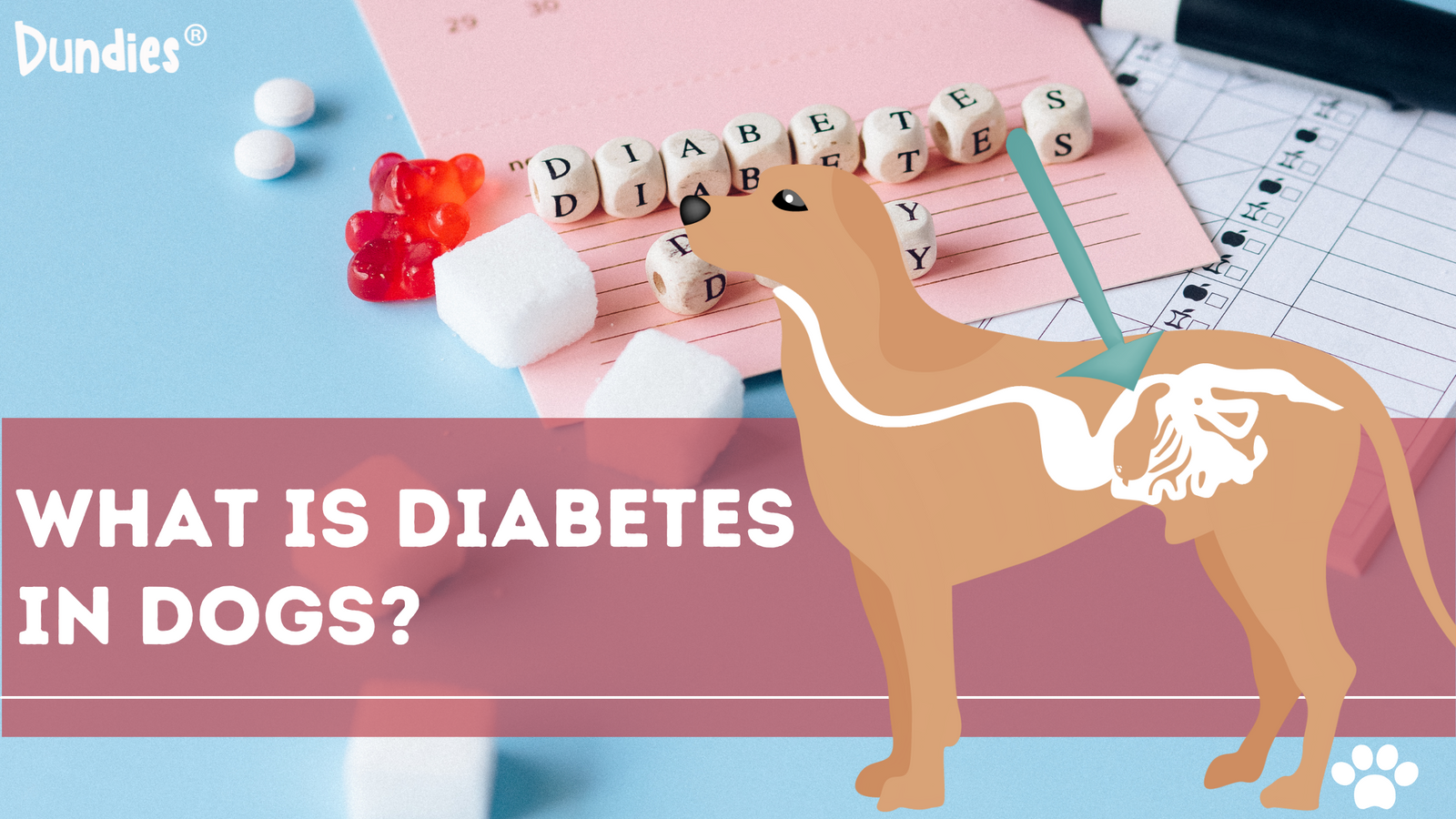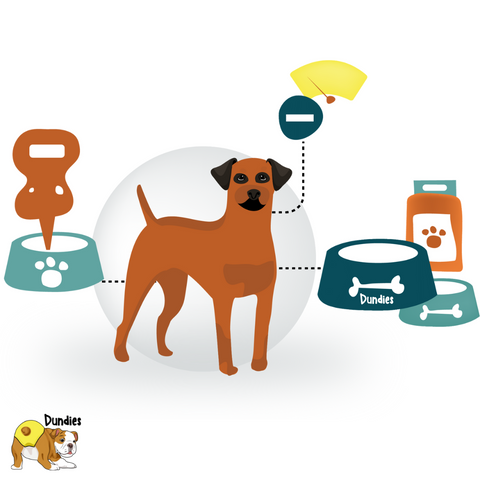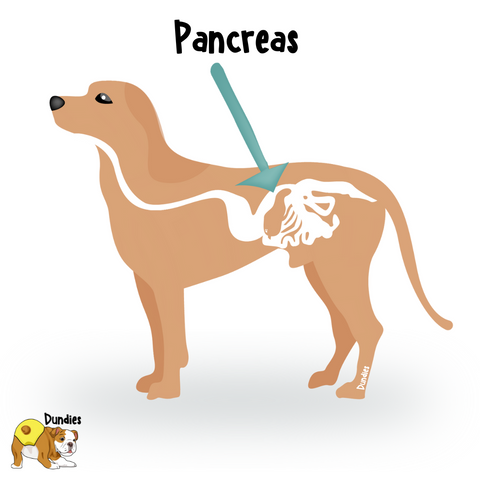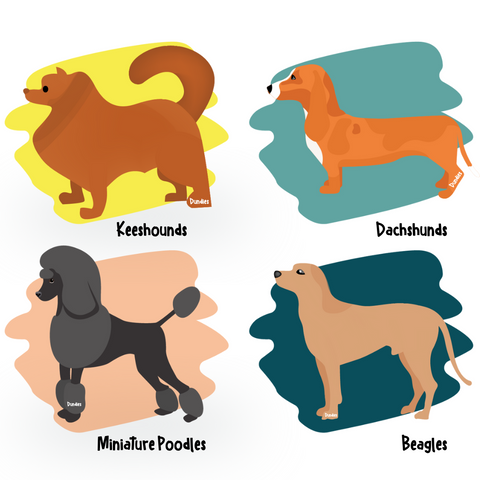
What is Diabetes in dogs?
You have likely heard of diabetes before, it’s a health condition commonly spoken about, but did you know it can also affect dogs? Diabetes is a chronic condition that affects dogs of all breeds and ages. The disease occurs when the body is unable to properly regulate blood sugar levels, which can lead to a range of health complications. While the causes of diabetes in dogs are not fully understood, there are several risk factors that can increase a dog's chances of developing the disease. Early diagnosis and treatment are crucial for managing the condition and preventing serious complications. With the right care and attention, dogs with diabetes can live long and healthy lives.
What Causes Diabetes in Dogs and the Types of Diabetes?

The causes of diabetes in dogs are not fully understood, but there are several risk factors that have been identified. Obesity, lack of exercise, and a diet high in sugar and processed foods can also increase a dog's risk of developing diabetes.
Age
Older dogs more commonly develop diabetes than younger dogs. Most dogs diagnosed are over the age of six.
Breed
Certain breeds are at a greater risk to develop diabetes. We will cover these breeds further down in the blog.
Obesity
Dogs who are overweight have an increased risk of developing diabetes. This is due to the fact that excess body fat can disrupt insulin production and regulation in the body.
Gender
Female dogs are more susceptible to developing diabetes than male dogs.
Genetics
It is possible that there is a genetic component to the development of diabetes in dogs, and some breeds are more genetically predisposed to the condition.
Underlying Health Conditions
Dogs with other health conditions such as pancreatitis and Cushing’s disease, may be at an increased risk of developing diabetes.
Medications
Certain medications, such as corticosteroids, may increase a dog’s risk of developing diabetes.

There are two main types of diabetes in dogs: type 1 and type 2.
Type 1 Diabetes
In type 1 diabetes, the immune system mistakenly attacks and destroys the insulin-producing cells in the pancreas, which leads to a lack of insulin production. This type of diabetes is thought to be caused by a combination of:
- Genetic susceptibility
- Environmental triggers, such as viral infections or exposure to toxins.
Type 2 Diabetes
In type 2 diabetes, the body's cells become resistant to insulin, which prevents glucose from being properly absorbed and metabolised. This can be caused by a range of factors, including:
- Obesity, a sedentary lifestyle
- Diet high in carbohydrates and sugars.
Some dog breeds, such as Poodles and Australian Terriers, may be more prone to developing type 2 diabetes due to their genetic makeup.
Regardless of the type of diabetes, maintaining a healthy weight and diet, and getting regular exercise, can help reduce a dog's risk of developing the disease. If you suspect that your dog may be at risk for diabetes, it's important to talk to your vet about strategies for prevention and early detection.
Signs and Symptoms

There are several signs and symptoms of diabetes in dogs that owners should be aware of. The signs and symptoms of diabetes in dogs can be subtle at first, and may develop gradually over time. Some of the most common signs of diabetes in dogs include:
Increased thirst and urination
Dogs with diabetes may drink more water than usual, and may need to urinate more frequently or in larger amounts.
Weight loss
Dogs with diabetes may lose weight, even if they are eating more than usual.
Increased appetite
Some dogs with diabetes may have an increased appetite, as the body tries to compensate for the lack of glucose being absorbed by the cells.
Lethargy
Dogs with diabetes may be less active than usual and may seem lethargic or tired.
Poor coat condition
The coat of a dog with diabetes may appear dull or greasy.
Sweet-smelling breath
Dogs with uncontrolled diabetes may have a sweet or fruity odour to their breath, due to the presence of ketones in the blood.
It's important to note that these symptoms can indicate other medical conditions as well, so it's really important to book in an appointment with your vet if you notice any of these signs or symptoms. Early diagnosis and treatment of diabetes is crucial for managing the condition and preventing serious complications.
What Breeds are at Risk of Diabetes?

Some breeds are more prone to developing diabetes than others.
These breeds include:
- Australian Terriers
- Cairn Terriers, Poodles
- Beagles
- Dachshunds
- Samoyeds
- Bichons Frises
- Pugs
- Puli
- Keeshounds
- Fox Terriers
- Miniature Schnauzers.
Diabetes can affect other breeds, these breeds are just more commonly affected.
How is Diabetes Diagnosed in Dogs?
Diabetes in dogs can be diagnosed through a combination of blood and urine tests. Your vet will first conduct a physical exam to check for signs and symptoms of the disease, such as increased thirst and urination, weight loss, lethargy, and a dull coat.
Your vet may also ask questions about your dog's diet and exercise routine, as well as any other medical conditions or medications that the dog is taking.
To confirm the diagnosis of diabetes, your vet will typically perform a blood glucose test, which measures your dog's blood sugar level. If the blood glucose level is high, the vet may also perform a urine glucose test, which detects the presence of glucose in the urine.
A glucose tolerance test may also be performed, which involves administering a specific amount of glucose and then measuring your dog's blood sugar levels at specific intervals over a period of several hours.
In some cases, additional tests may be necessary to rule out other medical conditions or to assess the extent of any complications related to diabetes. These may include a complete blood count or an analysis of your dog's urine.
If diabetes is diagnosed, your vet will work with you to develop a treatment plan just for your dog. This plan may include a combination of diet, exercise, and medication.
Regular check-ups and monitoring of blood sugar levels are essential to ensure that your dog is responding well to treatment and to prevent any serious complications from developing.Early diagnosis and treatment are crucial for managing the condition and preventing serious complications.
How is Diabetes treated in Dogs?

Diabetes treatment in dogs typically involves a combination of diet, exercise, and medication. The goal of treatment is to regulate your dog's blood sugar levels and prevent complications from occurring.
Diet
Dogs with diabetes typically require a diet that is high in protein and low in carbohydrates, to help regulate their blood sugar levels. Your vet may recommend a prescription diet or a homemade diet that is tailored to your dog's individual needs.
Exercise
Regular exercise is important for dogs with diabetes, as it can help regulate blood sugar levels and promote overall health. However, it's important to work with your vet to develop an exercise plan that is safe and appropriate for your dog.
Medication
Dogs with diabetes typically require insulin injections to regulate their blood sugar levels. Your vet will work with you to determine the appropriate dosage and frequency of insulin injections, based on your dog's individual needs. It's important to follow your vet's instructions carefully and to administer the insulin injections at the same time each day.
In addition to these primary treatments, your vet may also recommend other medications or supplements to help manage your dog's diabetes and prevent complications. Regular check-ups and monitoring of blood sugar levels are essential to ensure that your dog is responding well to treatment and to adjust the treatment plan as needed.
The key to managing diabetes in dogs is work closely with your veterinarian to manage your dog's diabetes and prevent complications from developing. With the right care and attention, dogs with diabetes are able to live long and healthy lives.
What are Complications of Diabetes in Dogs?

It is important to manage your dog’s diabetes to prevent complications. If left untreated or poorly managed, it can lead to a serious range of complications, including:
Hypoglycaemia
Low blood sugar levels can occur in dogs with diabetes, particularly if they receive too much insulin or don't eat enough.
Ketoacidosis
This occurs when the body breaks down fat for energy, resulting in the buildup of ketones in the blood. This can be life-threatening if left untreated.
Cataracts
High blood sugar levels can damage the lens of the eye, leading to the development of cataracts and potential vision loss.
Neuropathy
High blood sugar levels can damage nerves in the body, leading to weakness, numbness, and pain in the legs and feet.
Skin infections
Dogs with diabetes are more prone to skin infections, particularly in areas of the body where the skin is moist or warm.
Urinary tract infections
Dogs with diabetes may be more prone to urinary tract infections, which can be serious if left untreated
Pancreatitis
In some cases, diabetes can lead to inflammation of the pancreas, which can cause abdominal pain, vomiting, and diarrhoea.
Kidney Disease
Coma and death
It's important to work closely with your veterinarian to manage your dog's diabetes and prevent these complications from developing.
Recommended products to help support your pet
There are several products that can be helpful in supporting a dog with diabetes, including:
Glucose meters
Glucose meters are devices that allow you to monitor your dog's blood sugar levels at home. Your veterinarian can show you how to use one properly.
Insulin syringes
If your dog requires insulin injections, your vet will likely prescribe a specific type of insulin and syringe. It's important to use the correct type of syringe and to follow your vet's instructions carefully.
Prescription diets
There are several prescription diets available that are formulated specifically for dogs with diabetes. These diets are typically high in protein and low in carbohydrates, and can help regulate your dog's blood sugar levels.
Treats
If you want to give your dog treats, it's important to choose treats that are low in carbohydrates and high in protein. We love the treats from Laila and me, particular the freeze dried treats that are single protein.
Supplements
There are several supplements that may be helpful in managing diabetes in dogs, such as omega-3 fatty acids, probiotics, and antioxidants. However, it's important to talk to your vet before giving your dog any supplements, as some may interact with other medications.
Exercise equipment
Regular exercise is important for dogs with diabetes. You may also want to consider purchasing exercise equipment such as a treadmill or agility equipment, to help keep your dog active and healthy, a new leash and harness or a smart watch to track your workouts together. Stylish hound makes great pet exercise equipment.
Dog Nappies
To manage the frequent urination and messes that can occur with your dogs increased thirst and unintended accidents you can use reusable dog nappies or puppy pads. The reusable nappies and belly bands from Dundies and the Dundies reusable puppy pads are a great tool.
